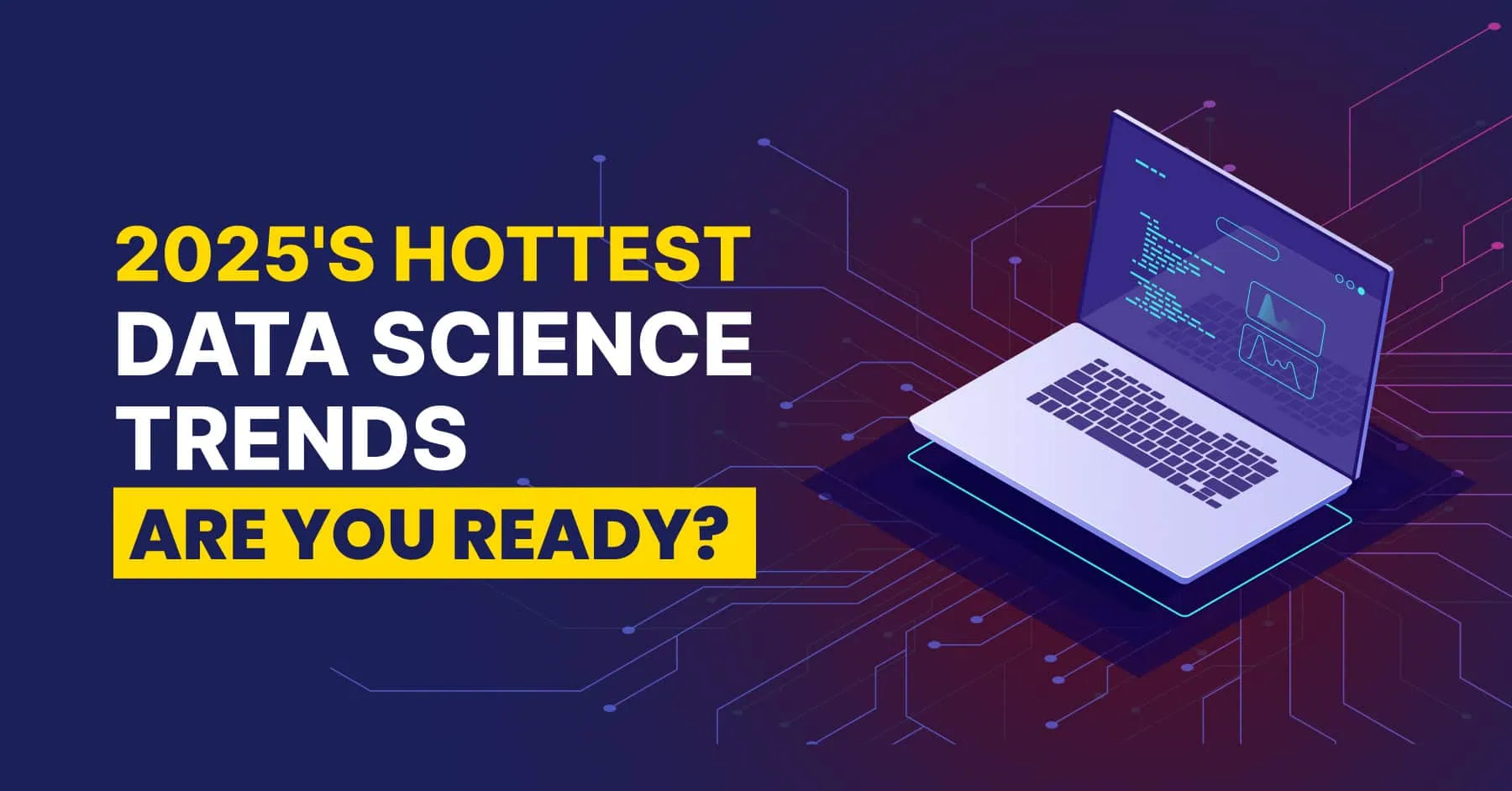As we dive into 2025, data science continues to evolve at a breakneck pace, reshaping how businesses, governments, and individuals make decisions. With AI becoming more accessible, data ecosystems growing more complex, and ethical concerns gaining prominence, the field is undergoing a transformation unlike anything we’ve seen before.
Whether you’re a data scientist, business leader, or simply data-curious, staying ahead of the curve is essential. In this post, we’ll explore the Top 10 Data Science Trends in 2025—from the rise of generative AI in analytics to the growing importance of data-centric AI development. These trends aren’t just predictions—they’re already shaping the future.
Let’s dive in and see what’s driving the next wave of innovation in data science.This blog will discuss latest trends in data science, whether data science requires coding, and how students can prepare early.
Why Staying Updated with Data Science Trends Matters in 2025
Given the quick speed of technological advancement and the changing demands of the industry, it is imperative to stay current with data science trends in 2025. Businesses need to change fast to remain competitive as AI, machine learning, and data-driven decision-making develop at a never-before-seen pace. Data science applications across industries are changing as a result of emerging ideas including generative AI, automated machine learning, and ethical AI. Professionals who keep updated may take advantage of these advancements, streamline procedures, and tackle novel problems, guaranteeing their continued relevance and efficacy in a field that is continuously moving toward increasingly complex, data-centric solutions. Ths is why data science students must start early and stay updated to stay competitive.
Does Data Science Require Coding in 2025?
Indeed, coding has always been a part of data science, with Python and SQL being essential for activities like data analysis, modeling, and manipulation. While SQL is necessary for database management and querying, Python’s robust ecosystem of libraries (such as Pandas, NumPy, and Scikit-learn) is crucial for creating and implementing machine learning models. However, there is less need for heavy scripting now that tools like AutoML and no-code platforms are becoming more popular. While requiring a basic understanding of code for further customization and optimization, these tools make data science more accessible by allowing users to develop models and analyze data with little to no programming experience.
So, does data science require coding? Yes, but many new tools in 2025 are making it easier for beginners to start without being expert coders.”
Top 10 Data Science Trends in 2025
1. AI-Driven Data Analytics
Data analysis will continue to be automated by AI and machine learning models, enabling businesses to gain deeper insights more quickly. Businesses can increase operational efficiency and generate more accurate trend predictions by using sophisticated algorithms to find patterns and make data-driven choices with little human involvement.
2. Augmented Analytics
The focus will be on augmented analytics, which incorporates AI and machine learning into conventional analytics tools. Even non-technical users will be able to obtain important business insights and make quicker, better decisions without heavily depending on data scientists because to the automation of data preparation, visualization, and insights creation.
3. Edge Computing for Real-Time Analytics
Edge computing will become crucial as IoT devices proliferate. Faster, real-time decision-making is made possible by processing data closer to the source rather than transferring massive volumes of data to centralized cloud servers. For sectors where latency is essential, such as healthcare, manufacturing, and autonomous vehicles, this is essential.
4. Explainable AI (XAI)
Explainability will be a key concern as AI models become more intricate. Businesses will give top priority to creating AI systems that provide transparency and comprehensible justification for their forecasts. This is especially crucial in regulated sectors like healthcare and finance, where trust and accountability depend on an understanding of AI judgments.
Curious how you can apply these trends in real-world projects? Get hands-on training with Inspiria’s B.Sc in Data Science Course.
5. Data Privacy and Ethics
Data privacy will become a major problem with more stringent laws like the GDPR. Businesses will increasingly use cutting-edge strategies like federated learning, differential privacy, and encryption to protect data privacy while upholding compliance and fostering customer trust as more gather and analyze personal data.
6. Synthetic Data
Synthetic data will become more and more common as a substitute for real-world data, particularly when accessibility or data privacy are concerns. Businesses can train AI models without jeopardizing sensitive data by using realistic, artificially generated datasets. This ensures diversity and lessens bias in the algorithms.
7. Automated Machine Learning (AutoML)
By making it possible for non-experts to create and implement machine learning models, autoML will democratize the development of AI. By automating the feature engineering, model selection, and hyperparameter tuning processes, these tools will enable companies of all sizes to use AI more easily and without the need for a specialized data science team.
8. Quantum Computing in Data Science
It is anticipated that quantum computing would transform data science by processing large datasets much more quickly than conventional computers and resolving intricate optimization issues. As quantum algorithms advance, sectors including finance, logistics, and medicines will gain access to previously unheard-of computational capacity that will speed up innovation and decision-making.
9. Advanced Natural Language Processing (NLP)
As NLP develops further, machines will be able to comprehend and produce human language more precisely. Applications like sentiment analysis, real-time translation, and automated content creation will advance significantly by 2025, enabling companies to interact with clients, handle unstructured data, and enhance user experiences on a large scale.
10. Data-Driven Predictive Maintenance
With predictive maintenance models, data science will be utilized more and more to anticipate and stop equipment faults. AI algorithms will predict problems before they arise by evaluating sensor data from machinery in sectors including manufacturing, energy, and transportation. This will save downtime and operational expenses while eventually improving business performance.
How to Prepare for These Data Science Trends as a Beginner?
Learn the fundamentals of coding first to keep current with data science developments. The majority of data science work is built on the foundation of two fundamental computer languages: Python and SQL. While SQL aids in effectively managing and querying databases, Python, with its vast libraries like Pandas and scikit-learn, is especially important for machine learning and data analysis.
After that, sign up for an introductory course that goes over important ideas like data cleansing, analysis, and visualization. Beginner-friendly courses are available on websites such as Coursera, edX, and Udemy.
To make sure you’re always up to date on the newest developments, you should also regularly read blogs, subscribe to emails, and listen to podcasts from prominent figures in data science.
How Inspiria Knowledge Campus Prepares You for the Future of Data Science
A thorough education in data science is available at Inspiria Knowledge Campus in Siliguri, preparing students for the rapidly developing sector. The course, which is designed especially for Indian students following the 12th grade, has a strong emphasis on hands-on learning. Students work on real-world projects and write code from start, guaranteeing practical experience in analytics, machine learning, and data manipulation. To help students make a smooth transition from academic learning to professional careers, the program offers internships with top companies, individualized mentoring from industry experts, and robust placement support. Inspiria is a great option for prospective data scientists in India since it combines state-of-the-art technologies and methods with practical experience to guarantee that students have the abilities needed to thrive in the ever-changing data science field.
Don’t worry about whether coding skills are required for Data Science or not! At Inspiria, Data Science students are trained to exhibit employable skills and be future ready.
Conclusion:
With advancements like edge computing, augmented analytics, and AI-driven analytics, data science has a bright future ahead of it in 2025. The need for qualified workers is growing as more sectors use data science to improve decision-making and address challenging issues. Mastering critical tools like Python, SQL, and machine learning while staying current with trends is crucial to remaining competitive. The route to success in data science is more obvious than ever, whether it is through internships, practical projects, or formal schooling. Now is the time to get ready if you have a strong interest in data and want to have a big influence. Are you prepared to take advantage of the countless chances that lie ahead in the field of data science?
So what are you waiting for?Apply now to the Data Science course at Inspiria Knowledge Campus and become the next-generation data expert!”











